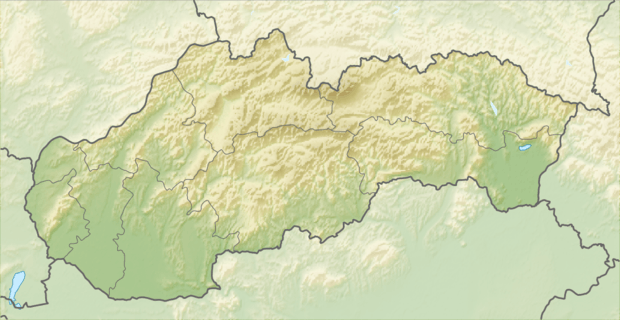Veľká Paka
| Veľká Paka Nagypaka | |
|---|---|
| village | |
 Location of the village | |
| Coordinates: 48°02′30″N 17°24′30″E / 48.04167°N 17.40833°ECoordinates: 48°02′30″N 17°24′30″E / 48.04167°N 17.40833°E | |
| Country |
|
| Region | Trnava |
| District | Dunajská Streda |
| First written mention | 1205 |
| Government[1][2] | |
| • Mayor | Alexander Hunka (SDKÚ-DS, Party of the Hungarian Coalition) |
| Area | |
| • Total | 18.355 km2 (7.087 sq mi) |
| Elevation | 123 m (404 ft) |
| Population (2001)[3] | |
| • Total | 676 |
| • Estimate (2008) | 811 |
| • Density | 44/km2 (110/sq mi) |
| Ethnicity[3] | |
| • Hungarians | 55,62 % |
| • Slovakians | 42,31 % |
| Time zone | UTC+1 (EET) |
| • Summer (DST) | UTC+2 (EEST) |
| Postal Code | 930 51 |
| Area code(s) | +421 31 |
Veľká Paka (Hungarian: Nagypaka, Hungarian pronunciation:[ˈnɒɟpɒkɒ], meaning ”Marketroad”) is a village and municipality in the Dunajská Streda District in the Trnava Region of south-west Slovakia.
Component villages
| In Slovakian | In Hungarian |
|---|---|
| Veľká Paka | Nagypaka |
| Čukárska Paka | Csukárpaka |
| Malá Paka | Kispaka |
Geography
The municipality lies at an altitude of 123 metres and covers an area of 18.356 km².
History
In the 9th century, the territory of Veľká Paka became part of the Kingdom of Hungary. The village was first recorded in 1205 as Paka. Until the end of World War I, it was part of Hungary and fell within the Somorja district of Pozsony County. After the Austro-Hungarian army disintegrated in November 1918, Czechoslovakian troops occupied the area. After the Treaty of Trianon of 1920, the village became officially part of Czechoslovakia. In November 1938, the First Vienna Award granted the area to Hungary and it was held by Hungary until 1945. The present-day municipality was formed in 1940 by unifying the three component villages. After Soviet occupation in 1945, Czechoslovakian administration returned and the village became officially part of Czechoslovakia in 1945.
Sepulchral artefacts were found in Velka Paka from the Bronze Age.
Landmarks
- The village has a modern cultural house and a motel.
- An important sacral historical building is the Roman Catholic St. Ladislaus church from 1317 to 1678.
Demography
At the census 2011 has village 879 people : 473 (54%) slovaks, 335 (38%) Hungarians and 71 (8%) others nationality. (In 1910, the village had 322, for the most part, Hungarian inhabitants. At the 2001 Census the recorded population was 676, at the 2008 811 people. 42,31 per cent is Roman Catholicism is the majority religion of the village, its adherents numbering 74.26% of the total population.
Sports
The village has a football club, named Druzstievnik F.C. Velka Pak which has an A team and a Junior Team. The A team is in the 2. league of the western-Slovakian football Association (ZSFZ). The Junior team is in the 3 class in the ZSFZ The junior team is full of talents: Top Scorers In The Year 2008/2009
- 1. Csivre Adam 18. Goals /14 match.
- 2. Penzes Attila 12.Goals /13 match.
- 3. Duhaj Tamás 11 Goals/7 match
- 4. Gasparik Tamas 10 Goals/15 match
- 5. Rences Balanit 3 Goals/12 match
Top " Goal Keepers
- 1. Makki Dávid 14 Saves/5 match. (7 Goals)
- 2. Szalay János 4 Saves /7 match (11 Goals)
- 3. Andrásy David 2 Saves/5 match. (16 Goals)
- 4. Kiss Zsolt 0 Saves/3 match. (5 Goals)
Current Squad: Goalkeepers (1):
- Makki Dávid: 235 Min
- Szalay János: 578 Min
- Andrasy Dávid: 367 Min
Defenfenders:
- 2. Horvath László 576 Min
- 3.Duhaj Tamás 'C' 599 Min
- 4.Szabó Sándor 492 Min
- 5. Svitek Adam 280 Min
- 6. Rences Bálint 678 Min
Midfielders:
- 7. Penzes Attila 685 Min
- 10. Milnak Daniel 559 Min
- 11. Sipos Dávid 179 Min
- 13. Valacsky Mihal 22 Min
Attackers:
- 8. Csivre Adam 691 Min
- 9. Gasparik Tamás 589 Min
References
- ↑ Local election results by the Statistical Office of the Slovak Republic, December 2006 Archived 11 August 2011 at the Wayback Machine.
- ↑ Local election 2010 results by the Statistical Office of the Slovak Republic Archived 11 August 2011 at the Wayback Machine.
- 1 2 "Urban and Municipal Statistics MOŠ". Archived from the original on 26 February 2011.